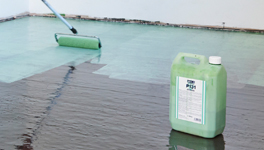F. Ball recommends the use of a primer prior to the installation of smoothing underlayments and adhesives, where required. Primers are designed to prevent unacceptably rapid drying of smoothing underlayments and adhesives and to increase the bond strength of floorcoverings.
Smoothing Underlayments
The integrity of smoothing underlayments can suffer if a primer is not used – a primer enhances the flow characteristics of a smoothing underlayment by preventing rapid drying, to ensure a long lasting, durable floor finish. Primers should also be used on absorbent subfloors to seal the surface helping to prevent pinholing which can occur as air is released from the subfloor.
F. Ball Stopgap P131 primer is designed to promote the adhesion of Stopgap smoothing underlayments to smooth non-absorbent surfaces, when applied neat. It can also be used dilute to prime absorbent surfaces helping to promote adhesion and aid workability of the smoothing underlayment.
Acrylic primers, such as F. Ball’s Stopgap P121, are specially formulated to penetrate calcium sulphate based screeds prior to the application of Stopgap 1100 Gypsum smoothing underlayment, thereby, reducing rapid drying, pinholing and promoting adhesion.
Adhesives
Priming is recommended prior to the application of an adhesive on certain absorbent surfaces, such as plywood. A primer reduces an adhesive’s water loss, which allows it to have a longer open time, making an adhesive easier to work with and helping to avoid late placement of floorcoverings.


